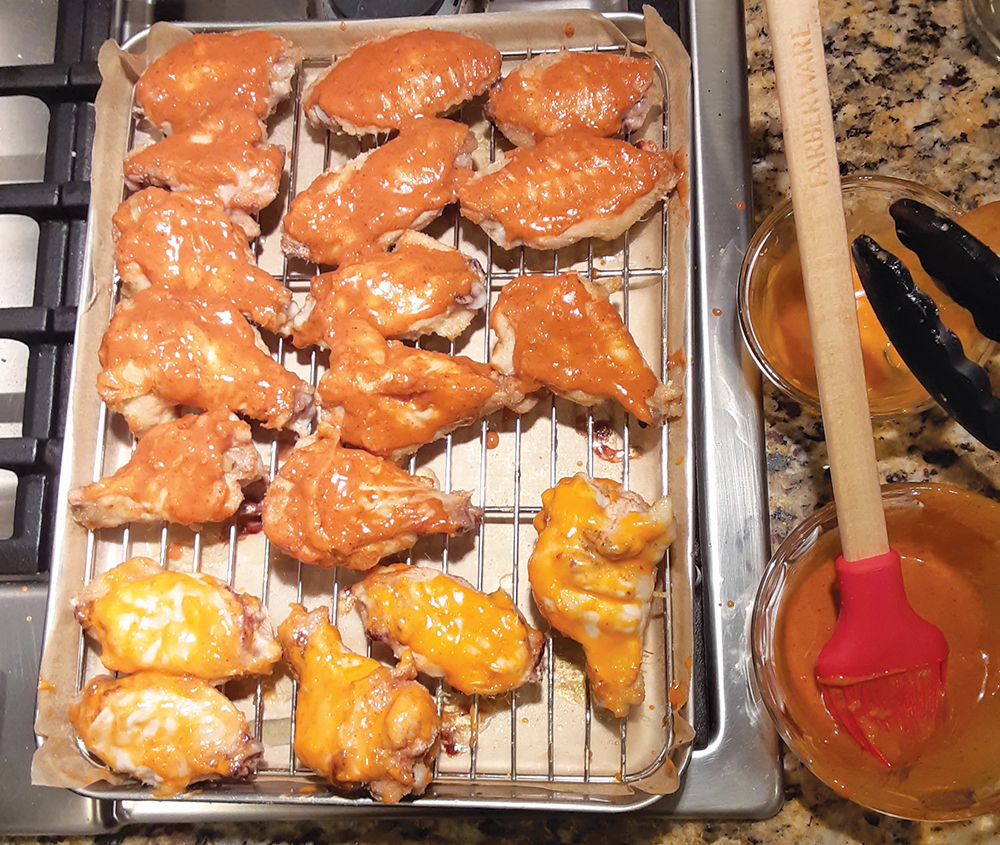Fine-tune the heat level, mild or hot.

for the oven.
Many kosher meats we now esteem as most desirable, such as brisket, were once considered cheap and undesirable. The impoverished Eastern European Jews learned to turn tough cuts of beef into such great foods that we now pay a premium for those cuts.
The story of chicken wings is similar. Antebellum, they were ignored as the worst part of the chicken and were often given to slaves, who then adapted them as a part of their cuisine. In the mid-1900s a Black chef in Buffalo, New York, covered wings with a mixture of sugar and Louisiana hot sauce, and Buffalo wings were born. A white chef nearby changed that recipe to butter with hot sauce, which is how we think of Buffalo wings today.
There are dozens of ways to cook Buffalo wings, and dozens of sauces. Wings can be roasted, fried or baked, then slathered in sauce and served. Sometimes the sauce is baked on. The wings can be dredged in flour, baking soda or aluminum-free baking powder before cooking, to make them extra crispy. Obviously, kosher sauces do not contain butter.
I devised Englewood and Tenafly sauce recipes for those who don’t like the excessive “charif” heat of Buffalo wings. By varying the amount of hot sauce versus French dressing, you can make these wings as hot or as mild as you wish. The recipes below use a 2:3 or 3:2 ratio. Feel free to make them 1:4 or 4:1, as you prefer. I put a bit of sugar in my recipes, in homage to their origins.
I must add that my family loves these wings so much that they have become a standard part of our Friday evening dinners; when Shabbat starts early, they keep fairly well on a warming tray at a low setting.
Cooking the Wings
Prepare the wings by cutting off the wingtips (you should own poultry shears used only for raw poultry), then cut each wing into two pieces at the middle joint. It may take a few tries to figure out where to make that cut most easily. Pull off any feathers, rinse well, and pat dry.
Dredge or toss them in a few tablespoons of flour—white or whole wheat—and set them on a rack over a roasting pan. A 9×12-inch rack is just large enough to hold about 10 cut-up wings.
My usual routine is to bake them in a preheated 350-degree oven for 35 minutes, which leaves the wings about half-cooked. Then I brush a sauce on each piece (recipes below), flip them over, brush them again, and return them to the oven to bake for another 40 minutes. With this formula, the wings come out somewhat juicy, and the sauce barely caramelized.
Try it, and then adjust the two timings to suit yourself. If you want the wings juicier, cook them for a few minutes less overall. If you want the sauce more caramelized, make the first cooking period shorter and the second cooking period longer by 10 or 20 minutes.
Here are three ideas for sauces, each recipe enough for about 6-8 wings.
Tenafly Wing Sauce
- 2 tablespoons creamy French dressing
- 3 tablespoons Chipotle Hot Sauce (Cholula brand)
- ½ teaspoon sugar
- 1 clove fresh minced garlic (or ½ teaspoon garlic powder)
Englewood Wing Sauce (mild)
- 3 tablespoons creamy French Dressing
- 2 tablespoons store-bought mild wing sauce
- ½ teaspoon sugar
- 1 clove fresh minced garlic (or ½ teaspoon garlic powder)
Honey Mustard Hot Sauce
- 2 tablespoons honey
- 2 tablespoons mustard, deli-style or Dijon
- Optional: Up to 2 tablespoons Sriracha sauce or Louisiana hot sauce
- Optional: 1 clove fresh minced garlic (or ½ teaspoon garlic powder)
Notes:
My favorite, by far, is the Tenafly wing recipe, but to make it you absolutely must buy the Chipotle variety of hot sauce made by Cholula. It is an amazing product. My family likes it so much that I buy it in 64-ounce jugs—geshmak!
Some kosher stores trim their wings excessively, to avoid the labor of plucking feathers. This greatly reduces their flavor. I generally stick with Empire brand wings, which are less trimmed, although they often need a bit more work to pluck the last few feathers off them. The best feather-plucker I’ve ever used is a small curved or bent-nose pliers from a hardware store — make sure it’s stainless steel so it won’t rust.
For Englewood wings, use any commercial brand of Buffalo wing sauce. I rather like the Sweet Baby Ray’s sauces, although they use canola oil (which my family avoids due to an allergy).
There are probably two dozen unique ways to cook wings. Roasted, fried, baked, grilled. If you don’t like my method, search the internet for “Buffalo wing recipes” and see what you can find. I used to dredge the wings in flour and fry them for eight minutes on each side, then bake them with a sauce, but they were a bit too oily for my tastes.
For easiest cleanup, soak the rack for a half hour or more, and then clean it by hand or in a dishwasher. I prefer to bake using a simple stainless steel rack and pan. The wings cook on top of the rack, and drip into the pan, so I cover the pan with parchment paper.
Leftover wings are fairly good for a few days, but not quite as good as freshly made.












